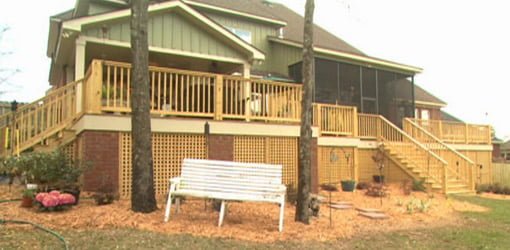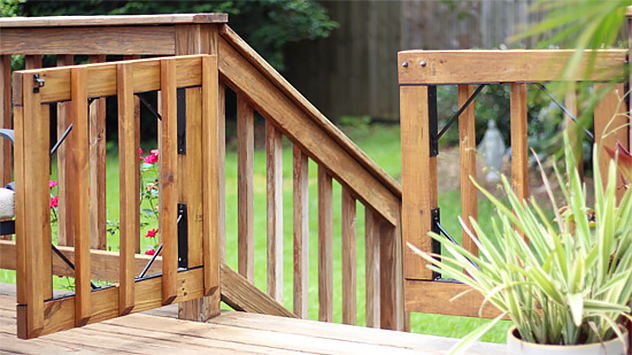If you live in a wildfire-prone area, choosing the right decking material can protect your home and even increase its value. Fire-resistant decking materials won’t stop a fire completely, but they can slow its spread, giving firefighters more time to respond and reducing the risk of total property loss.
The best fire-resistant decking options include fire-retardant-treated (FRT) wood, fire-rated composite boards, and autoclaved aerated concrete (AAC). Each material offers different levels of protection, durability, and cost. On average, fire-resistant decking costs between $8 and $12 per square foot installed, compared to $3 to $9 per square foot for regular wood decks. While the upfront cost is higher, these materials can be a smart long-term investment for safety-conscious homeowners.
Read on for more on the best fire-resistant decking materials, their costs, and key considerations for homeowners in wildfire-prone areas.
Top Three Fire Resistant Decking Materials
Wood is naturally flammable, but fire-retardant-treated (FRT) wood is pressure-treated with chemicals that slow down ignition and flame spread. Some homeowners prefer FRT wood because it retains the classic look and feel of natural wood while meeting fire safety standards.
FRT wood can also be used to reinforce the underside of decks, creating a protective barrier against windblown embers. However, it requires periodic retreatments to maintain its fire resistance, making it higher-maintenance than composite or concrete options.
If you’re looking for an affordable fire-resistant decking material that still provides the warmth of wood, FRT lumber is a solid choice—just be prepared for ongoing maintenance. For more information on taking care of your deck, check out our guide on pressure-treated wood deck maintenance tips.
Fire-resistant composite decking is a durable, low-maintenance alternative to wood that offers improved fire resistance. These boards are made from a blend of wood fibers and plastic resins, creating a material that resists moisture, warping, and insect damage. Composite decking has a few major perks:
- Fire Resistance – Slows flame spread more effectively than traditional wood.
- Durability – Won’t rot, crack, or splinter over time.
- Low Maintenance – No need for sealing, staining, or frequent repairs.
- Aesthetic Appeal – Available in various colors and textures that mimic real wood.
However, not all composite decking is fire-rated. If you live in a wildfire-prone area, look for composite boards that meet CAL Fire ignition resistance standards. Some high-quality composite boards achieve a Class B fire rating, offering better fire protection than untreated wood.
While fire-rated composite decking costs more upfront, its long lifespan and minimal upkeep make it a cost-effective choice over time, especially for homeowners in wildfire-prone regions.
A fire protection. These lightweight concrete blocks weigh about half as much as standard concrete but provide superior fire resistance and insulation. Unlike some materials, AAC is completely non-combustible and won’t emit toxic fumes when exposed to high heat. AAC also offers excellent fire resistance and durability:
- A 6-inch AAC block can withstand direct flames for up to four hours.
- Even a 2-inch AAC block resists fire for at least two hours.
- AAC can be used for decking, walls, and flooring, providing extra fire protection for homes in wildfire-prone areas.
While AAC offers unmatched fire resistance, it comes with higher material and installation costs. Cutting and placing AAC blocks requires specialized labor and expertise, which can drive up installation expenses.
However, for homeowners prioritizing maximum fire protection, AAC is one of the best investments. It not only enhances safety but can also increase home value in wildfire-prone regions.
Protecting Decks from Wildfires
Using fire-resistant decking materials is a great first step, but additional safety measures can further reduce fire risks and protect your home.
Fire Prevention Tips for Decks
✔ Apply fire-retardant finishes to exposed wood for added protection.
✔ Keep the area under your deck clear—flammable debris and stored items can ignite from embers.
✔ Ensure multiple exits so you have a safe escape route in case of fire.
✔ Keep an ABC fire extinguisher nearby to quickly put out small outdoor fires.
✔ Remove dry leaves, brush, and vegetation around your deck to reduce fuel for wildfires.
✔ Store flammable patio furniture indoors before wildfire season.
Taking these precautions—along with choosing fire-resistant decking and smart landscaping strategies—can significantly improve your home’s wildfire resilience.
Choosing Quality Fire-Rated Deck Boards
If you live in a wildfire-prone area, selecting the right decking material is crucial for safety and compliance with fire codes. When comparing fire-rated decking options, consider these key factors:
✔ Ignition Resistance – Fire-retardant-treated (FRT) wood and fire-rated composite decking ignite less readily than untreated wood.
✔ Flame Spread – Look for materials that slow the movement of fire across the surface, reducing the risk of flames spreading to your home.
✔ Combustibility – Noncombustible materials like autoclaved aerated concrete (AAC), stone, and metal provide the highest fire resistance.
✔ Durability – Choose materials that can withstand heat, embers, and long-term exposure without deteriorating.
✔ Maintenance – Fire-resistant coatings and treatments may need periodic reapplication to remain effective.
By selecting a high-quality, fire-rated deck board, you can enhance your home’s safety, meet local fire codes, and reduce wildfire risks.
Compare products’ actual fire ratings closely. Higher ratings signal better ignition resistance and overall fire performance. Aesthetics and cost also impact decking decisions. Partner with experienced deck builders to craft code-compliant, firewise outdoor living spaces shielding homes.
Is Fire-Resistant Decking Worthwhile?
While fire-resistant decking costs more upfront, it provides crucial protection for homes in wildfire-prone areas. Materials like flame-retardant wood, fire-rated composite boards, and nonflammable concrete can slow or prevent deck fires, reducing the risk of flames spreading to your home.
Beyond safety, firewise decks can also increase property value and may even help lower home insurance costs in high-risk fire zones. The long-term benefits—reduced fire hazards, lower maintenance needs, and potential savings on insurance—often make the investment worthwhile.
To find the best fireproof decking for your home, use the form below to get an estimate from a local deck contractor who understands local fire codes and safety requirements.
This site receives compensation from the companies featured in this listing, which may impact where and how products appear. This listing doesn’t feature all companies, products, or offers that may be available.
FAQs About Fire Resistant Deck Materials
The most fire-resistant decking material is autoclaved aerated concrete (AAC). It holds a Class A fire rating, meaning it can withstand direct flames and extreme heat for hours without igniting.
Other fire-resistant options include:
- Fire-retardant-treated (FRT) wood – Resists ignition but requires maintenance to stay effective.
- Fire-rated composite decking – Offers better fire resistance than untreated wood while being low maintenance.
If you live in a wildfire-prone area, Class A-rated materials like AAC or high-quality composites provide the best protection.
Fire-resistant decking is required in high-fire-risk areas, especially in states like California, where ignition-resistant materials are mandated for elevated decks, porches, and balconies in designated wildfire zones.
If you live near wildfire-prone forests or brush-heavy landscapes, check local building codes to see if fire-resistant materials are required for new or renovated decks.
Most Trex decking products have a Class C fire rating, meaning they provide some resistance but are not fully fireproof. However, certain premium Trex lines meet Class B ratings, offering better protection against fire spread.
For the highest fire resistance, look for composite decking brands that meet Class A standards, or consider concrete-based options like AAC.
Yes, but only if you use fire-retardant-treated (FRT) wood that meets wildfire zone safety standards. Standard wood decking is highly flammable and is not recommended for fire-prone areas.
If you prefer a natural wood look with better fire resistance, FRT wood is the best option—but it requires periodic retreatment to maintain effectiveness.
Fire-resistant decking costs more than untreated wood but provides better long-term protection. Here’s a quick cost overview:
- Fire-Retardant Wood: $6–$10 per square foot
- Fire-Rated Composite: $8–$12 per square foot
- Autoclaved Aerated Concrete (AAC): $15–$20 per square foot
In comparison, regular pressure-treated wood costs $3–$9 per square foot. While fire-resistant decks are more expensive upfront, they reduce fire risk, may lower insurance costs, and require less maintenance over time.










